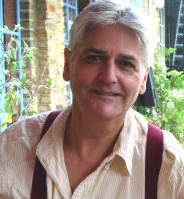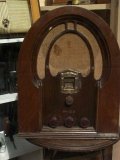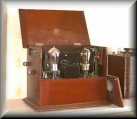Beck, Alan, 1985, 'Radio Drama "Playspeak", Speech and Drama, 34 (No 2) 15-20
|
[Page 15] ====================== Mrs. Hatch: (SOUND OF GOAL SCUTTLE BEING STRUCK.) Rev. Mosscrop: Mrs. Hatch: 'Week Ending' Team parody of Afternoon Theatre in A Day in the Life of Radio Four, broadcast 1983-09-03 on BBC Radio 4
1. Discourse analysis I wish to consider how close the language of popular radio plays is to the speech of real life and to examine radio's convention of naturalism. My approach is through linguistic analysis and discourse analysis, opening out the criticism of radio drama in ways which have been as yet unexplored. Since radio is confined to the aural, we should try to make use of analytical models appropriate to speech. My discussion also involves the effect of BBC production on the plays and an assessment of the state of radio drama criticism to date. I hope that this use of linguistics will be an aid to the notation of radio plays and to extending the grammar of radio criticism. 2. Playspeak For convenience, I will refer to the naturalistic language of Radio 4 plays as "playspeak". In the quotation above David Wade writes of their clichéd language and he rightly claims that there has been an improvement since "late 1960s domestic". His discussion takes him to this point. It is presumed that what makes a cliché is not only by comparison with other Radio 4 plays but also with real speech. The radio audience judges "playspeak" as appropriate and plausible by constant reference to "real life interaction" (a term in linguistics). Is radio "playspeak" constantly defeated in its attempts to imitate real speech? Is the naturalism of radio drama constantly endangered by cliché' and implausibility because of the limitations of the medium and of play production? Answers to such questions depend on how the audience accept the naturalistic convention and on how the listeners judge "play-speak" as close to realism. In broader terms, we require an aesthetic of radio drama and a phenomenological examination of its audience. 3. Radio 4 plays - statistics Radio 4 plays are popular drama in that the audience for Afternoon Theatre numbers 750,000 to 1,500,000 and for Saturday Night Theatre, 300,000. These are the most recent figures I have been given. Richard Francis, managing director of BEG Radio, as reported in The Times of 25110183 gave the ratings for Afternoon Theatre as 1.1% of the listening population (a small fall from 1.5% in 1968), Saturday Night Theatre 0.4% (a fall from 1.3% in 1968) and The Archers 0.6% (a fall from 2.8%). 5% of the available listening audience tunes in to radio in the evening. Whereas television gives the impression that it broadcasts to a family group in the livingroom, radio is for singles only as a private medium. Many in the radio audience could be listening as a secondary activity while they do something else around the house. Less than a quarter of Radio 4 listeners receive on VHF "quality sound" although 44% of the population own a tuner. Most of the audience stay loyal to one or two stations (JICRAR research), a rigid pattern of listening. [Page 16] 4. Domestic Realism
In dealing with the aural aspects of radio drama, I wish to draw on three areas of linguistic research - linguistic analysis, paralinguistic analysis, and discourse analysis. These are relatively new as can be seen by the rise of specialist journals in the field. Paralinguistic analysis of speech acts is concerned with whatever is not "dictionary" words and most of this is excluded from radio drama, such as gesture, spatial relationships, eye contact. (Radio drama can however represent some of these movements and relationships.) Discourse analysis is of what is above the level of the sentence. There may seem to be no limit set to this. I am concerned with applying discourse analysis to dialogue and with identifying patterns of dialogue. 6. Previous studies There are many problems in making use of linguistic models for the study of plays. I know of relatively few studies attempting to do this. Pinter's dialogue has been examined linguistically, and it can be shown in detail to be further away from the randomness of real life interaction than it is usually held to be. The chapter, "Dramatic Discourse" in Keir Elam The Semiotics of Theatre and Drama (Methuen 1980) is helpful. 7. Codes of representation in radio plays In contrast to linguistic analysis of the novel, the codes of representation in the play seem to pose more complex problems. The question is of the degree of representation or "mimesis". Each utterance in the radio play functions also as characterization and is a part of the action and of the play events. It is also directed at an audience in addition to its addressee in the dialogue. It must reveal its full meaning in its context and cannot be random or senseless. In radio "play-speak", we are dealing with highly patterned sentences and these must have a more intense meaning because they are concerned with play events and are often "gestural" in that they represent movement aurally. Real life dialogue is set in I / YOU roles, reveals its full meaning only to those involved (speaker, addressee) and is in a code restricted to shared knowledge and experience where much is to be inferred and need not be directly expressed. Play dialogue cannot be elliptical or "restricted" in this way. Radio "playspeak" must also be considered as the result of studio production and it is most often set in an indoors location. Recording on location outdoors and not in the studio has not always led to greater "authenticity", in my opinion. The problem is not merely that of sound ambience. This type of recording has not freed "playspeak" from its constraints. "Playspeak" is over-articulate in thought, emotion and situation and is frequently artificial in ways we feel we know all too well. This is the complaint I often hear people make against radio drama and they say that they know right away that they have tuned in to a play by the sort of speech they hear. Making allowance for the degree and nature of representation in "playspeak", we can use various research findings in linguistics to assess artificiality, plausibility and appropriateness. I will give some examples and I am not able to present a [Page 17] I would like to relate this matter structurally to the play and particularly to the opening and to the first utterances or "entrances" of characters. We form attitudes on the speaker's characteristics from his/her opening sentences. (This is the audience's task of reconstruction.) Hearers respond to accents like their own with "accent loyalty", for example. Radio drama conforms to such attitudes and expectations but at times reverses them. The protagonist in a Radio 4 play is almost always sympathetic and most often speaks RP. This can be contrary to status and dramatic situation. Conveying that the protagonist's status is below middle-middle class, for example, is sometimes left to other members of the family, children, sister, mother. It becomes confusing for me that the police officer protagonist in a Saturday Night Theatre "cops and robbers" play alone speaks RP while his colleagues have contrasting accents. But such is the BBC Radio convention, for the most part, and it is a survival of a genre which predates "Z Cars" and in which there is always a divide between cop and robber (as "Nelson of the Yard"). OAP protagonists most often have regional accents. The preponderance of RP accents may be due to convenience in production and to casting from the BBC Repertory Company (of thirty actors) and to the use of those who are already skilled in the difficult craft of radio acting. At times this results in too great a uniformity and age differences of characters are blurred or implausible. In Christoph Buggert's play, A Strangled Cry, broadcast 2215183 on Radio 3, and translated from German, both RP accents and a certain style of Repertory acting allowed no various distinctions of social status to emerge. The social satire of the original was not realized in the production. The first impression formed of the protagonist at the beginning of a radio play depends above all on the characterisation created by voice. The opening speaker in a play is frequently the protagonist and indeed this is a signal to the audience of his/her importance. I wish to appropriate the linguistic term "indexical information" - though properly it has a much wider application - and apply it in a particular way to the audience's first response to a character's "entrance". Indexical information defines a speaker's status and attitudes in real life interaction to a speech utterance made by him/her. In the following example, the "indexical information" given of a character in a radio play is incomplete and a minor "coup de theatre" is achieved within the confines of the medium. In Rachel Wyatt's play, Josie, broadcast 11110183 on Radio 4 (Afternoon Theatre), and recently repeated, the protagonist's boyfriend is Benjie and he speaks with a Yorkshire accent. Some five minutes into the play he reveals he is black, "You don't really need the jokes, just a funny suit, and the people roll about shrieking, laughing their 'eads off, pointing, "Rh! Look at him! What a Scream! He's got a Yorkshire accent and he's black 1"" However, without the "presence" of the actor on the stage, this important characteristic, which causes much of the plot conflict, could only be intermittently presented. (Benjie was played by Andrew Blanch.) A contrary example is Tom Stoppard's The Dog It Was That Died (9112182), a radio farce and parody thriller. All that is said in the first scenes and the "indexical information" presented of the characters, Purvis, Blair and Hogben, turn out to be only too (literally) true. [Page 19] My next two linguistic examples concern voice production. Silent pauses in real life dialogue have been measured and they range between 0.2 of a second to 2 seconds. (The pause occurs in articulation, hesitation and syntactical speech patterns.) Pauses in "playspeak", at times over-used and over-extended, can be assessed against this range. In such cases, the naturalism of "playspeak" can be investigated from some methodological base. A particularly difficult area is the description of voice quality. I. Laver has drawn up a system for labelling voice qualities which is of help even if only descriptive. Laver describes the distinctive individuality of one voice as a "setting" of physiological origin. It is part of the "quasi-permanent quality of a speaker's voice" due to idiosyncratic "long-term muscular adjustments or 'settings' . . . of the speaker's larynx and laryngeal vocal tract". (3. Laver, "Voice quality and indexical information", British Journal of Disorders of Communication 3 (1968) 43-54, and also 3. Laver and S. Hutcheson (eds.) Communication in Face to Face Interaction (London 1973) 189-203.) By adapting Laver's system, we could attempt to describe the distinctive vocal qualities of radio play actors. Not all of this labelling of voices will be adequate. Under "vocal setting" we could describe well-known "star" voices. Many of these radio "stars" are famous from film and the stage. All these voices provide the aesthetic pleasure of radio drama. Putting this linguistic information together, one could label Dinsdale Landen's voice. (He was recently heard in Golden by Mavis Hampton 1983-07-26, Afternoon Theatre, the repeat of Simon Moss's Love Me Tender, Afternoon Theatre, originally 1982-01-13, and as Purvis in The Dog It Was That Died.) Landen has a distinctive "vocal setting", the "breathy voice", with considerable range, particularly in the lower pitch. He makes idiosyncratic use of prolonged articulatory pauses and of additions of a paralinguistic nature to the script (as Ummm, Aaah). This latter element is particularly noticeable in his radio and stage roles (recently On the Razzle, Sufficient Carbohydrate and Loot). He is known for his pacing and articulation of extended monologues. (The casting of well-known actors in radio plays creates an expectation of a certain kind of entertainment and the context for "reading" the plays both by their roles and the actors' own personae. Some dramatists write for particular actors and voices.) Nicky Henson in Another Monday by Colin Finbow 1982-10-07 Afternoon Theatre, possesses a "vocal setting" with "creaky voice" (using Laver's term), with deep bass pitch range. He makes no paralinguistic additions beyond breathy hesitations. By contrast, Miriam Margolyes' radio performances are extraordinarily protean in her range of voices, and in rendering accent and age. Her "vocal setting" might be called one of the least individuated. Glenda Jackson's performance in Howard Barker's Scenes From An Execution 14110184 Radio 3 displayed both her own qualities of vocal ability combined with a force of delivery whose power derived from the stage. The result was a new high in radio acting and the play is one of the most [Page 20] important to emerge since John Arden's Pearl of 1978. (For a description of actors and production, see John Tydeman, "The producer and radio drama: a personal view" in Lewis Radio Drama pp.12-27.) My last examples are drawn from discourse analysis. W. Labov supplies a model for reported events in two-way conversation ("Rules for Ritual Insults" in D. Sudnow (ed.) Studies in Social Interaction (New York 1972) pp.120-70). These are divided into A-events (known to speaker A), B-events (known to speaker B), and AB-events (known to both A and B). Domestic radio "playspeak" is frequently over-explicit, to a point beyond plausibility of character and situation, particularly in the exposition. The radio husband and wife for example, tell each other of events in too great clarity of detail. The challenge to the dramatist is to present AB-events with a plausible style of discourse and yet not becoming elliptical. This could confuse the audience. A-events and B-events have the benefit of novelty. When speakers refer to shared AB-events, they use a style which stresses solidarity between them and which is elliptical. (This is a distinctive feature in Pinter's plays.) Much use is made of "repeats" and "confirming" here. My last models are those which describe extensive patterns of dialogue. Radio "playspeak" is highly patterned, at times rigidly so, particularly in "turn-taking", the division of utterances between speakers. "Playspeak" prefers paired "turn-taking" as in question and answer, demand and response. These pairs are called "adjacency pairs" and one character is frequently dominant by taking the lead. Turn-taking is rare~ violated. A radio play scene usually plunges "in medias res" and cuts out the opening and closing rituals of real life dialogue. What we get is mid conversation. The goals of radio conversation are often declared early in the scene (request for information, questions, topics). The conversation has a clear shape and all is appropriate and competent. There is a clear sequence of topics. Cohesion and structure typify most dialogue in plays and the novel, and it is functional as opposed to conversation as social activity and as a means of avoiding silence. My argument i~ not against naturalism as a mode in radio drama but I am in favour of greater variety in form and dialogue. I particularly admire the advances made by Cohn Finbow in fast-moving, complex dialogue and in the intermixing of monologue. (His plays include Another Monday, A Fair in the Park and Teddy Bears' Picnic.) Perhaps a fresh approach to radio drama dialogue could be attempted through group improvisation and group scripting. Improvisation has made little or no impact on radio drama as opposed to most, if not all other forms. (A recent exercise in improvising a play by producer James Runcie for Radio Scotland has not been broadcast in England.) This experiment in radio improvisation is one which could be attempted by an amateur group and results could be edited on tape. At least one could investigate how improvisation exercises could improve rehearsal and the "take". Under present conditions in the BBC, improvisation is too expensive. Experimental pieces on Radio 3 are rare and an attempt at anti-naturalism and "alienation" using human voices would be interesting to assess. I have offered some additions to the grammar of radio criticism. The test of my argument is inductive - to notate a scene of radio drama in detail and to analyse each signifier with a "reading" of the dialogue. One could start with an Afternoon Theatre opening scene, and then move on to Giles Cooper and David Cregan, and develop a methodology. [ends] |

|
|



